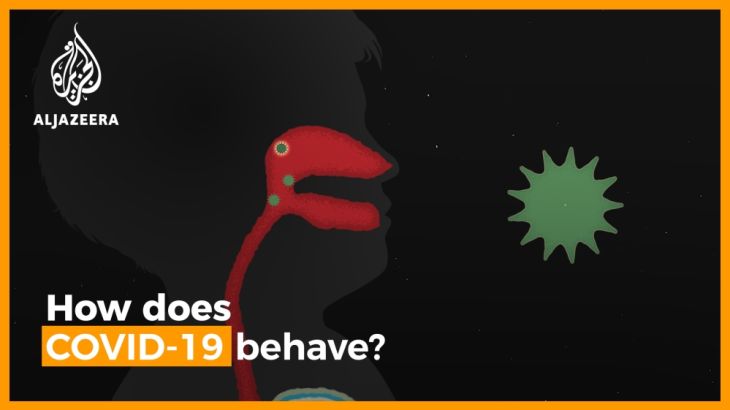
Animation: How do I know I have coronavirus?
How does coronavirus behave? Dr Amir Khan helps explain in our animation.
The new coronavirus that emerged in Wuhan, China in December has infected more than 720,000 people across the globe, plunging the world into a global pandemic.
But what do we know about the disease caused by the virus and how it spreads? Dr Amir Khan explains how the new coronavirus behaves in this animation.
Keep reading
list of 4 itemsMexico’s teachers seek relief from pandemic-era spike in school robberies
‘A bad chapter’: Tracing the origins of Ecuador’s rise in gang violence
Why is the US economy so resilient?
Like other coronaviruses, the new virus – which causes a disease now called COVID-19 – is transmitted from person to person via droplets when an infected person breathes out, coughs or sneezes.
It can also spread via contaminated surfaces such as door handles and railings.
Scientists in China who studied swabs from infected patients say the new coronavirus behaves quite like flu viruses.
It has an incubation period of between one and 14 days and a study in the Journal of the American Medical Association has found new evidence that the virus can be spread asymptomatically.
Coronavirus infections have a wide range of symptoms including fever, coughing, shortness of breath and breathing difficulties.
“The initial symptoms, particularly if it is in your throat, that kind of thing, the body will recognise it as a foreign agent, the virus,” Dr Amir Khan explains to Al Jazeera.
“And it will mount its first line of defence. And part of that is getting a fever. And one of the reasons people get a temperature and a fever is because a lot of bacteria and viruses don’t like hot environments. It’s not an ideal environment for them to multiply and reproduce. So actually having a fever, it reduces the rate at which they can reproduce.”
Mild cases can cause cold-like symptoms, while severe cases can cause pneumonia, severe acute respiratory illness, kidney failure and death.
“As it moves down into your respiratory tract, into your lungs, it can start to affect your breathing because the lining of the lungs become infected,” Dr Khan explains further.
“And again, whereas the lungs should be inflating and deflating as air comes in and out like a balloon, the cells are unable to do that job and they start producing the virus instead. So the lungs don’t inflate and deflate as well.”
This video was produced, animated and edited by Al Jazeera NewsFeed’s Adam Adada.